What I’m Up To at Kirkus This Week,
Plus What I Did Last Week
(featuring a chat with Charles R. Smith Jr. and artwork from
Andrea Cheng, Bryan Collier, Floyd Cooper, Kadir Nelson,
and James E. Ransome)
 February 1st, 2013 by jules
February 1st, 2013 by jules
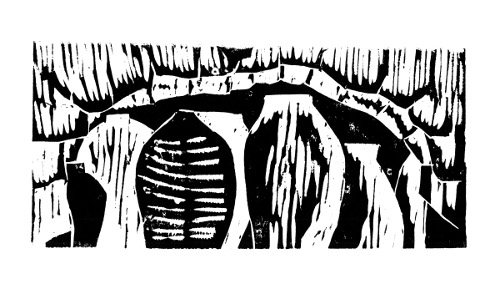
for all of South Carolina / to come and see our wares. /
Whoever buys the big one / will never know /
I made that jar.”
— Illustration from Andrea Cheng’s Etched in Clay:
The Life of Dave, Enslaved Potter and Poet
There were more protests, more rallies, and violence. The people needed a leader.
Nelson snuck a message to the people: ‘I will return.'”
— Spread from Kadir Nelson’s Nelson Mandela
(Click to enlarge spread, sans text)
Yes, lots of folks are visiting today.
First up, today over at Kirkus, I write a bit about two Maurice Sendak reissues. That link is here. (Just yesterday a friend sent me this link, too. Wow.)
Last week at Kirkus was “Going Beyond Black History Month.” Today, I share art from the books mentioned in that column, but I’ve got two added-extras: Author Charles R. Smith Jr. visits briefly to talk some about Brick by Brick, and I’ve also got some woodcuts from Andrea Cheng’s Etched in Clay: The Life of Dave, Enslaved Potter and Poet. This is a collection of free verse poems about the life of the potter, which was just released last month by Lee & Low Books. The book is filled with Andrea’s stark, beautiful woodcuts. I’m still reading this one — and enjoying it. Here is Kirkus’ starred review of the book.
Let’s get right to the art and the brief chat with Charles. You will see art below from the following books (illustrations from each book, followed by the book cover); all of these books were included in last week’s column, with the exception of Cheng’s:
- Charles R. Smith Jr.’s Brick by Brick, illustrated by Floyd Cooper (Amistad/HarperCollins, 2013)
- Lesa-Clina Ransome’s Light in the Darkness: A Story About How Slaves Learned in Secret, illustrated by James E. Ransome (Disney/Jump at the Sun, 2013)
- Nelson Mandela by Kadir Nelson (Katherine Tegen Books/HarperCollins, 2013)
- Etched in Clay: The Life of Dave, Enslaved Potter and Poet by Andrea Cheng (with woodcuts from Ms. Cheng), published by Lee & Low Books (2013)
- Fifty Cents and a Dream: Young Booker T. Washington, written by Jabari Asim and illustrated by Bryan Collier (Little, Brown, 2012)
- In the Land of Milk and Honey, written by Joyce Carol Thomas and illustrated by Floyd Cooper (Amistad/HarperCollins, 2012)
On a related note, there’s this from Robin Smith at BookPage.
Enjoy the art.
 Charles R. Smith Jr. (pictured right) on Brick by Brick: “The idea for this book actually came from my editor at Harper. She had a book from the adult division about George Washington and read something about how the White House was built. She didn’t know much beyond that but thought it would make for a compelling book.
Charles R. Smith Jr. (pictured right) on Brick by Brick: “The idea for this book actually came from my editor at Harper. She had a book from the adult division about George Washington and read something about how the White House was built. She didn’t know much beyond that but thought it would make for a compelling book.
The research was not easy, since it’s not a well-covered topic. I found a few books that mentioned it only a little, but I hit the jackpot when I came across an out-of-print book that the author posted online. It basically showed, step by step, the process of planning and then building the White House. The only problem was that there was so much information, I had to weed through it all to create an easy-to-follow story of, basically, a house being built in the middle of nowhere. Ultimately, I focused on how the work the slaves did would now be done by machines, but since those machines didn’t exist, I had to show the physical toll it took. That led me to focusing on the hands of each worker and use of the word ‘hands’ in general. Because, as I mention in my end note, ‘hand’ not only refers to a body part, but it also refers to someone who helps.
become mortar for bricks / spread by slave hands. /
Will / Nace / Gererd / Manuel /
Liverpole / Lester / Herbert / Samuel /
Slave hands spread mortar / twelve hours a day, /
but slave owners take / slave hands’ pay.”
(Click to enlarge spread, which is sans text here)
Through my research, I came across ledgers of names of slaves used in various jobs and added them to the story to bring those names to life. Too often we think of slaves with no names or faces, and it was important to remind readers that the monumental task of clearing a forest and building a house were done by humans with none of the modern equipment we have access to today.
shillings to be free / and no longer a slave. /
Slave hands count shillings / with worn fingertips /
and purchase freedom / earned brick by brick.”
(Click to enlarge spread, which is also sans text here)
Once the research was complete, I needed a way to tell the story in a simple way. I learned that slaves that worked in the cotton fields would sing songs that set a work cadence and helped pass the time, so I wrote the poem in that style. The rhythm and cadence is slow but methodical — with key words and phrases repeated for emphasis and effect. In the end, it gives a nice rhythm to the book and makes it easy to read outloud.“

Incidentally, I asked Charles what is next for him, since I was curious. His response:
“I am currently at work on a novel that centers around mixed martial arts (MMA), as I have been a fan for years. Not many novels exist on it as a sport, and I look to create, not just one, but many others on the subject for years to come.
This summer, I have a picture book coming out that I wrote and did the photos for, called I Am The World [Atheneum Books for Young Readers]. It celebrates the diversity of cultures here in America by showing different foods, language, music, and clothing brought here from other countries. I had a lot of fun doing the book and look forward to it coming out.“
Mama holds my hand tight and pulls me close. ‘Follow me,’ she says, even softer.”
(Click to enlarge spread, seen here sans text)
and those letters will spell out words.”
(Click to enlarge spread)
This time I don’t hold on to Mama’s skirt, but I stay close.
Sometimes she has to pull me to help me keep up. …”
(Click to enlarge spread, seen here sans text)
Someone kneels to pray. I grab Mama’s hand so hard she makes a face.
The horses stop above us, and so does our breathing.”
(Click to enlarge spread)
One by one we all start breathing. …”
(Click to enlarge spread, seen here sans text)
Nelson hammered rocks into dust, and read, studied, and educated fellow prisoners.
Days turned into weeks, months, and years.”
(Click to enlarge spread, also sans text here)
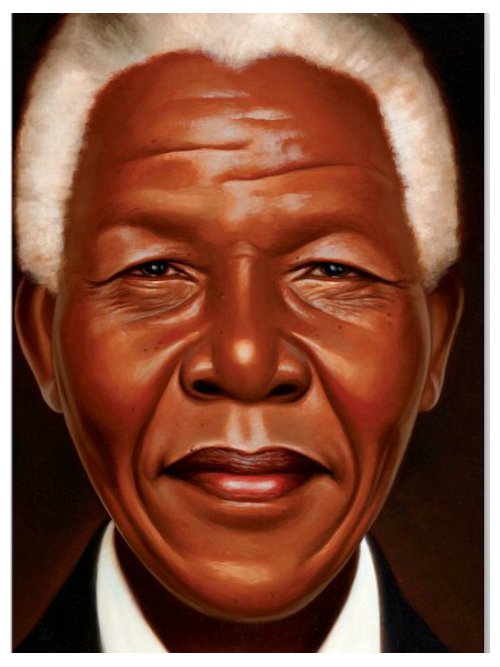
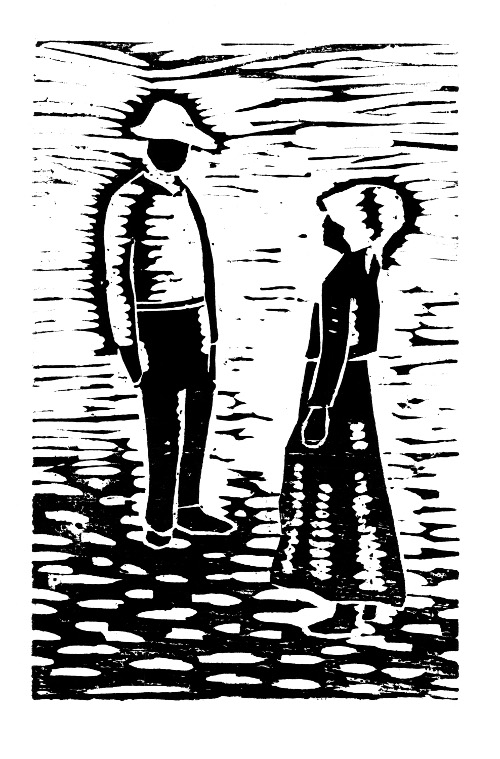
He kisses me / on the cheek, / and I take his hand.”

with his voice, / splitting husbands / from their wives, /
mothers / from their children …”
(Click to enlarge spread, sans text)
Soon they began to make sense. ‘A an apple. B a bird.’ At last, he could read.”
(Click to enlarge spread, sans text)
But he wanted more.”
(Click to enlarge spread, sans text)
basking hood-eyed / on dazzling rocks …”
(Click to enlarge spread, sans text)
shimmy in and out of each other’s arms / And ever-changing rhythms /
call the feet to follow the beat / here in /
this Land of Milk and Honey”
(Click to enlarge spread, sans text)
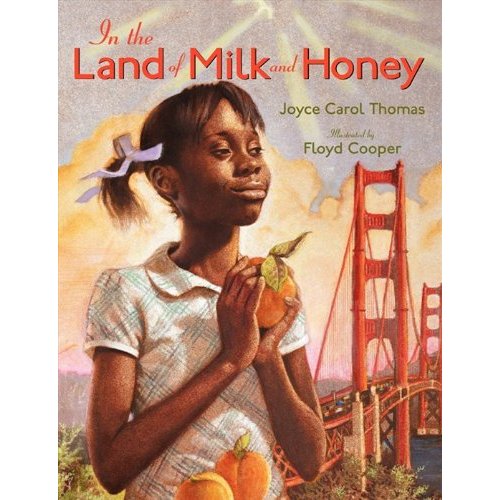
ETCHED IN CLAY: THE LIFE OF DAVE, ENSLAVED POTTER AND POET. Copyright © 2013 by Andrea Chang. Published by Lee & Low Books, Inc., New York. Illustrations used with permission of the publisher.
NELSON MANDELA. Copyright © 2013 by Kadir Nelson. Published by Katherine Tegen Books, an imprint of HarperCollins, New York. Spreads used with permission of the publisher.
BRICK BY BRICK. Copyright © 2013 by Charles R. Smith Jr. Illustrations © 2013 by Floyd Cooper. Published by Amistad, an imprint of HarperCollins, New York. Spreads used with permission of the publisher. Photo of Charles R. Smith Jr. used with his permission.
LIGHT IN THE DARKNESS: A STORY ABOUT HOW SLAVES LEARNED IN SECRET. Copyright © 2013 by Lesa-Cline Ransom. Illustrations © 2013 by James E. Ransome. Published by Disney/Jump at the Sun Books, New York. Spreads used with permission of James E. Ransome, as well as the publisher.
FIFTY CENTS AND A DREAM. Copyright © 2012 by Jabari Asim. Illustrations © 2012 by Bryan Collier. Published by Little, Brown and Company, New York. Spreads used with permission of the publisher.
IN THE LAND OF MILK AND HONEY. Copyright © 2012 by Joyce Carol Thomas. Illustrations © 2012 by Floyd Cooper. Published by Amistad, an imprint of HarperCollins, New York. Spreads used with permission of the publisher.
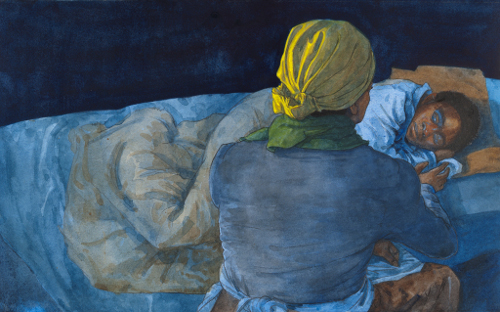
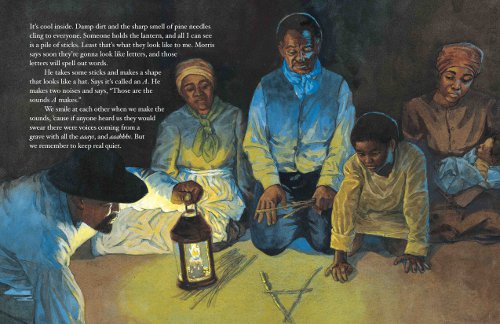





My kids and I have enjoyed reading several of the Cline-Ransom’s picture book biographies. My son has read the Satchel Paige biography many many times. I enjoyed reading the story about Major Taylor. I think Lesa does a great job of telling these people’s stories in a way that is both informative and easy to read.
I look forward to seeing Kadir Nelson’s Nelson Mandela biography.
Wow wow wow. So much beauty here today. I’m currently on a Bryan Collier kick. All these books look amazing!!
Oooooooh.
I was JUST thinking “beauty!” and that’s a good word, Jama-james.
I LOVE Charles R. Smith, and while I love his other work (he’s just the nicest man!) I’m excited that he both wrote and photographed the work for I AM THE WORLD. MY PEOPLE is so awesome, and I’m overjoyed to see more from him in that vein. Can’t wait!
Such gorgeous art to celebrate BHM! I hadn’t seen the artwork for FIFTY CENTS AND A DREAM before and I am very, very in love with it.
Thanks for including ETCHED IN CLAY in your roundup, too! Don’t know if you’ve seen it, but Andrea Cheng shared some photos of how she created the woodblocks here: http://blog.leeandlow.com/2012/12/05/how-to-make-a-woodblock-print/
Trying to reach you, can’t seem to find your contact info. Get back to me!